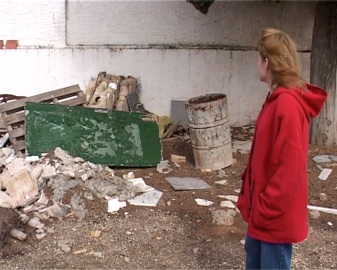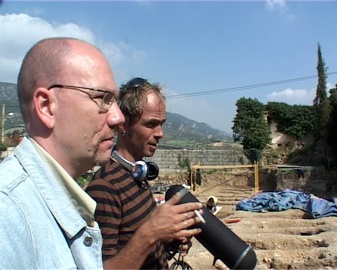
"Get down from your high horses, mr Swede! Come down from heaven!"
Padre Abad Anselmo Alvarez, abbot at the monastery by Franco’s grave
In september 1975 General Franco had signed his last death sentences. I was eight years old and my older brother described in detail how five young activists were to be killed. So when I participated in my demonstration march, I knew very well why I was walking there. On TV prime minister Olof Palme called Franco's people devils of murderers. He also said that fascism in Spain was about to fall and that the historical judgement would be atrocious and harsh. To the eight-year-old his words conveyed hope and confidence.
Two months later, the dictator died. At nine-year-old Mari Carmen's house, the parents opened a bottle of champagne they had been keeping for years.
Mari Carmen at the End of Silence is the story of what happens when a country tries to amputate its past.

In february 2006 we're standing by a pile of garbage by the cemetery of La Puebla de Cazalla. And Mari Carmen España is furious.
Six months earlier she found out what happened to her grand father 70 years ago. After 40 years of dictatorship and 30 years of silence she is determined to put her history in order.

2006 - the year of the historical memory in Spain - we start our journey around Spain and come across:
- two mayors, one socialist and one rightist, both with difficulties to handle the past.
- a professor of forensics who devotes all his vacations to helping people finding their relatives in mass-graves.
- a dead dictator resting in a black sanctuary maintained by the Spanish state.
- catholics worshipping by the dictators grave.
- one-eyed 74 year old Felipe, who bursts into tears whenever he is asked about his father.
- the son of a murdered liberal carpenter, Ampelio, stating that the Church and the Right should apologize.
But we keep coming back to Mari Carmen, following up her strife for the justification of her grandfather.
So far the judgment of History has failed to come. Mari Carmen at the end of Silence is the story of people taking it into their own hands.

Director’s statement
In a world where one of the major issues is how to achieve a decent world order; where the crimes of dictators can be accounted for and their victims justified; the Spanish example is of universal interest.
During the official year of the historical memory I start my journey around Spain with my old friend Pontus Hjortén. He has lived in Granada the last eight years, without understanding how the monuments of fascism are still standing inside the city, while several thousands of its democrats are lying in ravines, along roads and in olive groves outside the city.
Spain is a country deeply loved by its fellow europeans. Some fifty millions of us go there every year. And who knows how many of us, windswept northwestern europeans, cherish the dream of a small house in the south of Spain. We all love Spain. The fact that what we know as the Costa del Sol; the Sun Coast, just as well could have been named the Blood Coast, is a well kept secret so far. But something is about to happen.
With the words of Olof Palme about the atrocious judgment of history we come to explore this. The spanish expression ”hacer el sueco” – do the swede – is one of our methods.
Confronting politicians from both left and right, as well as the Catholic church, we finally get questioned ourselves.

Martin Jönsson and Pontus Hjorthén
